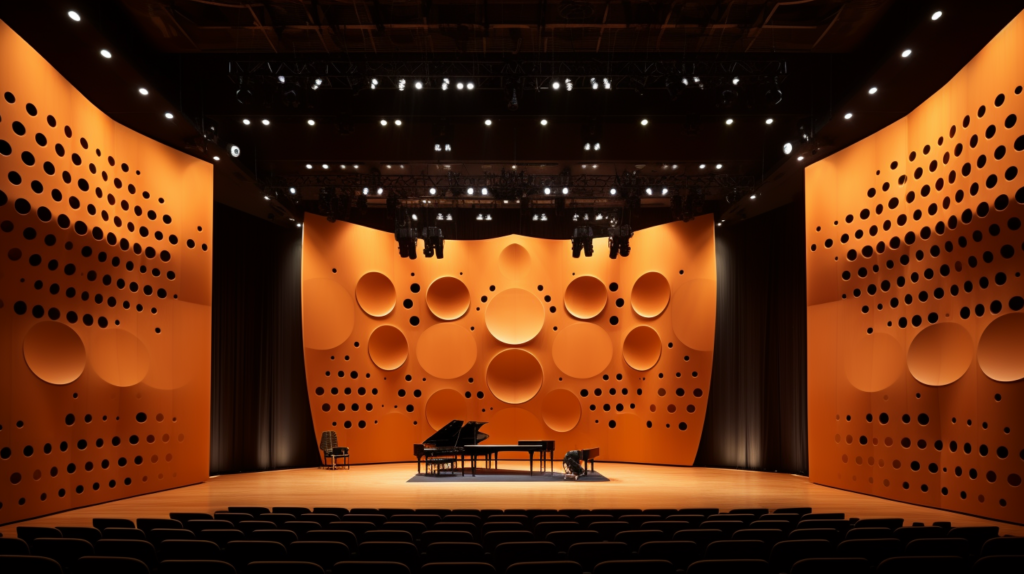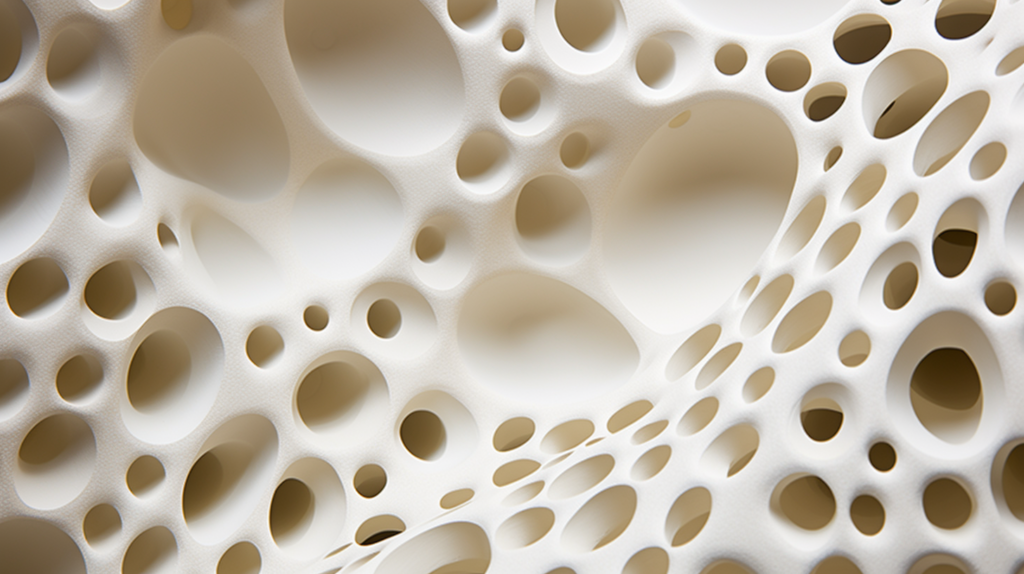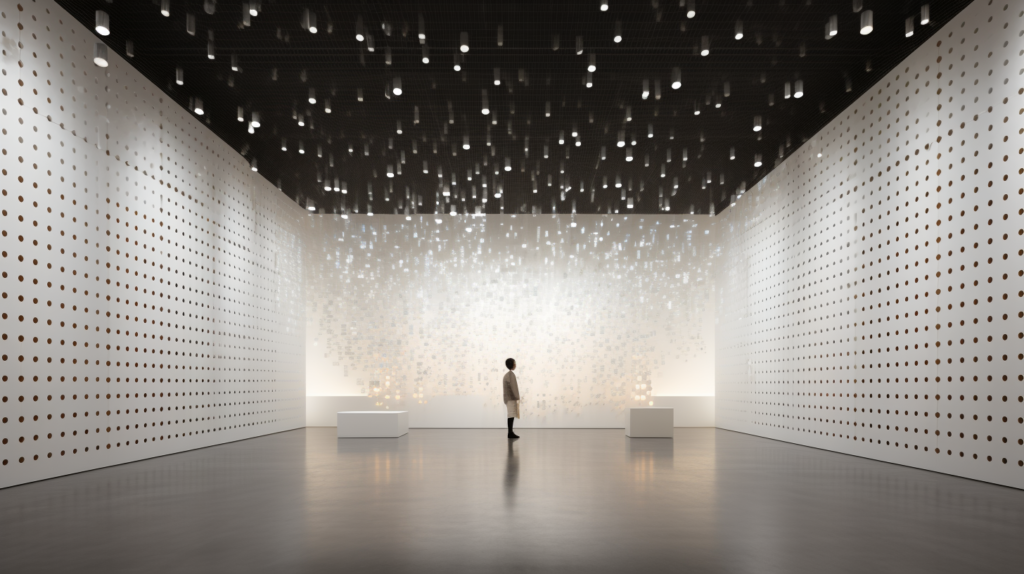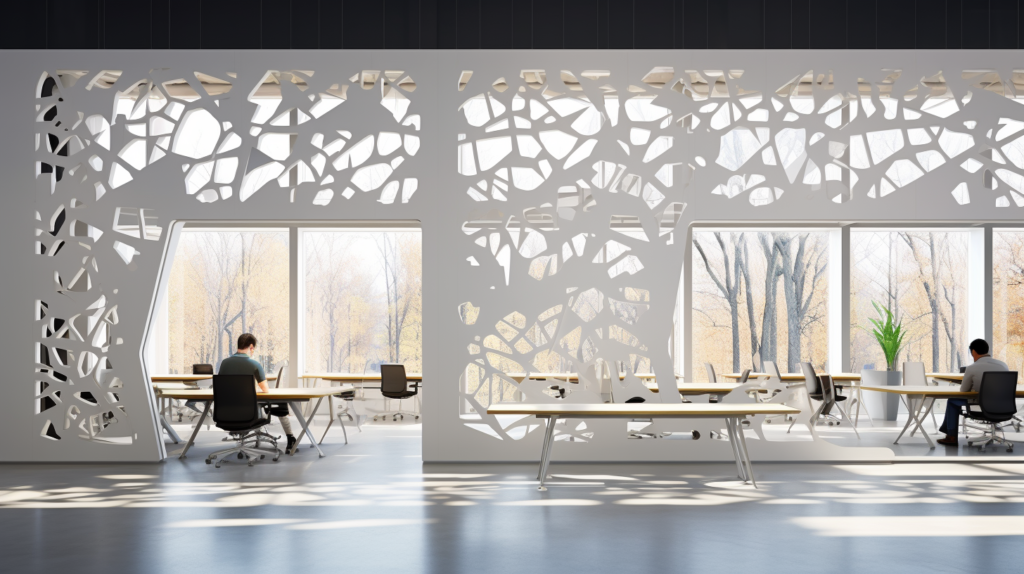Whether it’s the droning hum of an HVAC system, the echo of voices in a hallway, or the boom of music through shared walls, excessive ambient noise can make any space unbearable.
But what if a simple architectural detail could absorb and block sound right at the source?
Perforated acoustic wall panels provide an optimized noise control solution through their specialized hole and backing design that allows customized absorption of problematic sound frequencies without sacrificing aesthetics.
In this guide, we’ll explore the benefits of perforated acoustic panels and why they beat other treatments.
Let’s dive in.
What Are Perforated Acoustic Panels?

Perforated acoustic panels are a specialized type of architectural wall panel constructed with small holes that allow sound waves to pass through.
The holes work together with sound absorbing backing materials like fiberglass, mineral wool, plastic or other porous absorbers to effectively absorb and disperse sound waves.
Perforated acoustic panels are commonly used as an interior finishing treatment to improve room acoustics by reducing unwanted echo, reverberation and other issues caused by hard sound reflections in a space.
Perforated panels help prevent sound from bouncing wildly around an interior environment.
They are often professionally installed in auditoriums, theaters, concert halls, studios and other performance venues where fine-tuned acoustic control is absolutely vital.
However, perforated acoustic wall panels can also be easily added to any residential or commercial rooms struggling with echo and reverberation to greatly enhance the interior sound quality.
Absorbing Sound in Rooms
Perforated acoustic panels can be mounted on walls, ceilings, and even corner areas to strategically help absorb and deaden sound within a room before it has a chance reflect off hard surfaces.
Read more on how do acoustic panels work
Perforated panels are an ideal type of decorative acoustic treatment that can provide an effective and affordable solution to common room acoustic problems by absorbing sound directly at the source and blocking sound travel.
The hole and backing design essentially trap sound waves and prevent them from freely bouncing around, reducing the overall ambient noise within the space.
How Do Perforated Acoustic Panels Work?

The small, precision perforated holes that give these specialized panels their name allow sound waves to smoothly enter inside the panel cavity and become partially trapped within the sound absorbing backing material layered behind.
Both the exact size of the holes and the distribution pattern and density play a critical role in the acoustic performance and overall sound absorption capabilities.
Generally, an increased number of holes, as well as subtly larger hole sizes, will allow for noticeably increased absorption of noises across a wider spectrum of sound frequencies.
This includes improving reduction of lower frequency sounds that can often be challenging to properly absorb.
Additionally, the specific hole size pattern can actually be strategically customized to target absorption of different sound frequency ranges and types of noise depending on the unique needs of the environment.
Optimized to Address Sound Issues
This intentional hole engineering allows the perforated acoustic panel’s physical design to be tailored and optimized to address the primary sound sources and most disruptive or damaging sound frequency ranges present in the specific room.
Applications where clear speech delivery is critical like corporate boardrooms and school classrooms often utilize perforated panels with small hole patterns best suited for absorbing mid to high frequency sounds.
Performance spaces may incorporate variable hole patterns to achieve the desired warmth and reverberation timing.
Dissipating Sound Energy
Sound waves move through the air until they encounter a physical barrier like a wall, floor or ceiling surface.
When sound makes contact with conventional hard surfaces it reflects back into the space.
This is why untreated rooms with lots of hard walls, floors and ceilings suffer from excessive echo, reverberation and ambient noise buildup.
Sound bounces rapidly around the hard room surfaces becoming increasingly unintelligible.
Perforated acoustic panels address this through a two-fold approach.
First, the numerous small holes allow the sound waves to penetrate through the physical panel surface to enter the interior rather than instantly reflect off the face.
Once inside, specialized sound absorbing backing materials like fiberglass, mineral wool, plastic or cotton are designed to contact the sound waves and effectively dissipate the acoustic energy so it does not continue vibrating and reflect back out into the space.
How To Install Perforated Acoustic Panels For Effective Sound Control?

By effectively absorbing and dispersing sound through the carefully designed perforations and audio tuned backing, perforated acoustic wall panels prevent and reduce hard sound reflections that create echo, excessive reverb and ambient noise buildup.
This is what brings noticeable improvements in overall interior acoustic comfort and sound quality.
Intelligibility of speech and music clarity is enhanced when harsh reflections are brought under control.
Strategically mounting perforated acoustic wall panels directly at the initial sound source points and in the first key sound wave reflection zones allows for maximum absorption to be achieved.
Recommended placement includes covering walls adjacent to sound-generating equipment like televisions, speakers or machinery as well as application on ceiling areas above workspaces, seating areas or stages where early reflections are likely to occur and degrade occupant comfort.
Reading Guides On Where & How To Install
How To Install Acoustic Panels
How To Hang Your Acoustic Panels?
How High to Hang Acoustic Panels?
How to Remove Acoustic Panels?
How to Acoustically Treat a Room for Crystal Clear Vocal Recordings?
Should You Put Acoustic Panels Behind Speakers? Your Questions Answered
Where To Place Acoustic Panels?
Where to Place Acoustic Panels in a Home Theater?
How to Acoustically Treat a Large Hall for Clear Sound
The Complete Guide to Acoustic Treatment: Acoustic Panels, Bass Traps, and Room Acoustics
Optimizing Acoustic Panel Design
There are a few key factors to consider when selecting and designing the perforated acoustic wall panels for your specific space in order to optimize them for your precise needs and sound issues.
As previously noted, the actual size of the drilled hole pattern will have a significant impact on the range of sound frequencies absorbed.
Generally smaller hole sizes ranging from 1/8” to 3/8” are better suited for absorbing and damping higher frequency sounds while moderately larger hole sizes from 3/8” to 5/8” will allow improved absorption of the often problematic lower frequencies and bass tones.
The overall thickness and depth of the full wall panel also impacts acoustic performance.
Thicker wall panels containing greater interior cavity space and backing material depth provides increased low frequency absorption capabilities across a broader spectrum of sound frequencies regardless of whether they are lower or higher pitched sounds.
Tuning the Acoustic Properties
Installing perforated acoustic wall panels with a total thickness ranging from 1” to 4” can provide the necessary depth required for effectively absorbing the complete range of human audible sound frequencies.
It is this increased panel thickness and backing depth that gives perforated acoustic panels superior low frequency absorption capabilities compared to thin acoustic foam sheets often limited to only high frequency absorption.
The specific composition and density of the wall panel’s internal sound absorbing acoustic backing material itself also plays an integral role in determining the overall acoustic frequency absorption characteristics.
Backing materials like fiberglass, mineral wool, plastic, cotton and others all demonstrate unique sound wave interaction properties and will accordingly absorb different sound frequencies at varying rates depending on these physical characteristics.
Targeting Problematic Frequencies
It’s very important to carefully consider the most significant and problematic noise sources and the primary frequencies when determining the ideal perforated hole size and engineered backing combination.
Concerts, sporting events and dance clubs struggling with intense low frequency noise like bass or kick drums may warrant large perforations paired with densely packed rigid mineral wool for maximum low frequency capture.
Smaller perforations and lighter density acoustic backing materials make sense for restaurants, open office spaces and classrooms trying to minimize speech and other mid to high frequency ambient noise that distracts patrons and impacts work productivity.
Installation for Acoustic Retrofits
One of the benefits of perforated acoustic wall panels is that they can be easily installed on-site directly on existing walls, ceilings, and even corner areas using basic mechanical fasteners like adhesive, screws, or suspended wire clips.
This allows acoustic retrofitting of problematic rooms without major expensive construction and demolition.
It is not necessary to completely cover every single wall and ceiling surface either.
In many cases strategically mounting the perforated wall panels in the most troublesome sound areas is most cost effective.
Panel placement can also be adjusted incrementally until the desired degree of sound absorption and noise reduction is subjectively achieved.
Spreading panels out provides better overall room coverage than just one large concentrated block.
Aesthetic Options and Visual Appeal
The perforated acoustic wall panels can actually be painted or otherwise decorated to match or complement the aesthetic of the existing wall finish and surrounding room décor.
Design-minded clients may specify bold colors or patterns for visual impact.
The key is just to take care and not accidentally fill in the essential perforations with paint or other obstructions during this finish application process, as blocking the holes will greatly reduce acoustic performance.
One great advantage of perforated acoustic wall panels over other options like fabric wrapped solid panels or foam sheets is their visual appeal and design versatility.
The perforated hole pattern itself provides natural articulation to break up the surface in an aesthetically pleasing manner.
Perforated panels look crisp and intentional versus basic foam that can appear haphazardly glued up.
What Are The Benefits Of Perforated Acoustic Wall Panels?

There are many great benefits to using architecturally engineered perforated acoustic wall panels as a sound absorbing and sound blocking interior finish treatment.
The combined effect of the carefully tuned hole pattern and the specialized sound absorbing backing materials allows for an aesthetically pleasing application that looks clean and purposeful.
The holes can form interesting geometric shapes, gradients and graphic patterns that enhance space.
Beyond their pleasing aesthetic design qualities, perforated acoustic wall panels also deliver exceptional acoustic control performance by absorbing ambient sound energy evenly across a wide frequency range from the low bass pitches all the way up through the high frequencies.
Read more to understand do acoustic panels work?
Intelligibility of speech and music is improved through precision reduction of any harsh or excessive reverberation.
Enhancing Speech and Sound Quality
Properly strategically mounted perforated wall panels have been scientifically proven through acoustic testing to enhance speech, music and overall sound quality by effectively absorbing point source noises and minimizing intense reflections that can continue circulating throughout a space.
Diffusing sound waves and reducing echoes and ambient reverberation helps improve concentration and communication.
Balancing Absorption and Openness
Perforated acoustic wall panels provide noticeable sound absorption and an acoustically “drier” environment without requiring total sound isolation like massively thick one foot concrete walls or small vocal booths.
The perforations still allow some sound passage to retain a sense of vibrancy and openness while the backing material absorbs a great deal of the sound energy.
This balanced acoustic approach prevents spaces from feeling uncomfortably “dead” like recording studios while still managing noise.
Versatile Acoustic Solution
Compared to basic acoustic foam sheets or minimalist fabric covered solid panels, perforated acoustic wall panels enable much superior focused sound blocking, diffusion and ambient noise control when thoughtfully engineered and then strategically mapped for proper placement.
The customized hole sizing and backing material provides broadband frequency absorption.
Overall, architecturally engineered perforated acoustic wall panels deliver an attractive, effective and affordable solution for significantly improving interior acoustics.
Their versatility, aesthetics and proven acoustic control performance makes perforated panels an ideal option for effectively reducing excessive echo and ambient noise in a wide variety of applications including both commercial office spaces and residential living spaces.
Perforated panels can provide mobile sound barriers when floor-to-ceiling ceiling installation is not possible.
Conclusion
Perforated acoustic wall panels provide an architecturally pleasing and highly effective solution for enhancing interior acoustics in a wide range of spaces.
Their unique hole and backing design allows for customized sound absorption across the frequency spectrum without requiring dense, unattractive industrial materials.
Strategically placed perforated wall panels absorb problematic reflections and ambient noise directly at the source before they can bounce wildly around a room degrading speech clarity and sound quality.
Beyond impressive acoustic control capabilities, perforated panels bring an aesthetic versatility through varied hole shapes, sizes and patterns that solid panels simply cannot match.
Perforated acoustic wall panels can unobtrusively blend into a sophisticated space or make a bold visual statement as desired.
The choice of colors and ability to paint the panels expands design flexibility even further.
For residential, commercial and professional environments where controlling sound reflections, echo, excessive reverberation and ambient noise is critical for function, productivity and comfort, perforated acoustic wall panels present an optimized solution.
Perforated panels outperform acoustic foam and other options through enhanced low-end absorption and focused sound blocking where needed most.
Perforated acoustic wall panels check all the boxes for performance, design and affordability.
